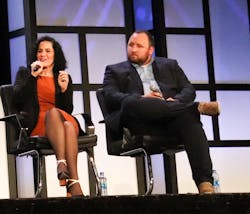Current execs turn attention to trucking's next generation of leaders
As the commercial vehicle world continues its technological evolution, industry executives are grappling with a changing workforce and the need for new skill sets. How today's leaders process data and foster the next generation of trucking executives are two pillars to set up a foundation for success.
This was the major message during a leadership panel discussion at the 2023 Heavy-Duty Aftermarket Dialogue in Grapevine, Texas, earlier this month.
During the session, four up-and-coming leaders from commercial vehicle industry suppliers wrestled with and advised on how trucking can prepare itself for a changing of the guard.
What skills does trucking need?
With data and technology continuously becoming a larger part of trucking, has this changed the skill sets needed to be brought into the industry? In short, yes, according to the panel.
Jack Chung, VP of product management at Noregon Systems, said it's important to differentiate “what kind of data we’re looking for,” whether that be vehicle data generated through ADAS components, EV battery systems, electric motors, and more, or geographic data, such as in route planning, or even driver behavioral data.
“We have a huge amount of data that’s being processed,” he said. “The most important thing, for my company and myself, is trying to understand how we can utilize that data and generate a conclusion that’s useful for our customers and for our research and development as well.”
Chung added that Noregon is looking for data scientists, as should others.
“When thinking of the ‘back office’ jobs that have been historically pen and paper—now they’re getting digitized,” said CJ Biank, global market manager at Grote Industries. “How can we start training the people we have, or bringing in people who have that type of background, that familiarity with systems and platforms, so they can succeed?”
The goal here is to be able to translate and relay that data into useful information for end users.
“I think you also need to look at, ‘how does that data get to the end user?’” said Julie Alfermann, director of central region sales at Allison Transmission. “You can have a data analyst that comes up with a conclusion, but how do you make that information easily digestible so that it’s understood by the field? I think that’s where our younger generation comes in. They really are going to be the creatives who make that data usable in the hands of our fleets and in the hands of those fleet managers.”How does the industry attract those skills?
Fleets can become more attractive to younger people, women, and those that have advanced skill sets by being aware of the next generation’s desire for a higher quality of life—or a more distributed work-life balance.
“The reason I can be here in Dallas today is because my husband’s company has flexibility so that he can do school drop-offs and pickups," Alfermann stated. "As we’re getting into more of a hybrid work environment where you understand that maybe your work is more effectively done at home, or maybe you’re in the office, but you leave early—that’s OK. It’s OK to recognize that you have a life outside of work. I think that benefits keeping people in general, male or female, in the industry.”
See also: Understanding Gen Z could be key to unlocking staff shortages
Beyond work-life flexibility, being able to relay to candidates more than just a job description of the role, but more so how that role fits into the big picture, can go a long way, Biank suggested.
“When you think of this younger generation coming into the workplace, something that they all are, whether it’s consciously or subconsciously, they’re builders,” he said. “They don’t want to be handed a task list Day One. They want to feel that sense of ownership, that they’re building something or they’re accomplishing something. And I think that’s really how to start catering to that audience. It’s not showing them, ‘Hey, you’re gonna be doing A, B, C, D.’ No, it’s ‘You’re creating this new platform, ecosystem, tool,’ whatever it might be. You have to show them what that end goal is.”
And for attracting women into the industry, Alfermann said it’s about awareness—and it needs to start early on. For example, her company attends job fairs for middle schoolers and high schoolers so that when they are old enough to attend job fairs in college, they are aware of not only the company but that that side of the industry is present and available.
And a job fair tip: “Make sure that there are women at that table from your company,” she said, “so that when people are coming to talk, they see that there are other women that have grown up in the industry. It provides them with the idea that that can be them, too.”
Furthermore, when looking to recruit and onboard, understand that biases exist and be cognizant of how candidates are evaluated, the panel suggested.
“When you’re looking to hire a woman, make sure that you have the right people on the hiring panel that are going to value her right,” suggested Tanya Miracle, director of OE truck/trailer at Bridgestone. “It’s human nature to hire someone that’s like us. If you have a panel full of middle-aged men, they’re likely going to choose a middle-aged man because we value what is like us. You need to make sure that your hiring panel is diverse enough that they’re valuing the full candidate array because I think we’re getting a lot of applicants, and they’re just not transferring into those roles that they could be.”
How do you prepare the next generation for leadership positions?
Baby Boomers have been retiring and leaving the industry; and during COVID, even some Gen Xers have exited the workforce. Today, Millennials are being placed into high level positions as a result. So, how can a fleet manage a career path for their future leaders? The best strategy: engagement.And in order to keep younger leaders engaged, Miracle suggested, it helps to diversify what individuals are working on.
“Make sure they have the opportunity to grow by working on a project that might be outside of their typical day to day… where they get that broader perspective and have that growth mindset while still staying inside their role,” she said.
Furthermore, having structures in place for training and mentorship are critical for career development, the panel resoundingly agreed.
Biank related his experience of coming into the industry and having a mentor with over 20 years of industry knowledge. Going through a mentorship with that individual has placed him in a position to be a mentor to others today.
“I think about giving them the opportunities and giving them enough leash that they feel that they can go on their own; they’re not being micromanaged,” Biank said of his mentorship strategy. “There’s no helicoptering. They’re on their own, doing their thing. And I think they see and respect that. And when the time comes that they have to talk about it, we talk about it. They’re very open to all feedback, whether it’s positive or negative feedback. I think giving them the opportunity to fail or to succeed is huge.”
“A mentoring program doesn’t just help the mentee learn,” Miracle related from her mentorship experiences. “It also gives us a network. As their pillars have grown, so have mine. So, my network still stays above me. I still have those people to bounce ideas off of and get a broader perspective.”
How can a potential leader find such opportunities?
If you are a mid-management leader looking to take on more, the HDAD panel suggested multiple routes to pursue in order to successfully expand your role.
“Be confident. Be assertive. Confidence is key,” Biank emphasized.
“Find what you’re passionate about and then exploit it,” Miracle followed. “And make sure you talk about it with every single person at your organization that you know.” Miracle related her experiences prior to her current role, where she created a new role for herself through persistence as she would bring the latest news and developments in future powertrain technologies to her superior and would ask how her team could follow suit. Eventually, she posed that this role become her full-time job, and it worked.
“Finding that thing that really drives you, and then making sure everyone knows it is what drives you, really can help you elevate yourself to that leadership position,” she surmised.
Chung concurred that passion is the number one thing potential leaders should take ownership of. He, too, stepped outside his previous role to become an in-house expert in the latest CARB and other emissions-related developments, which led to his ability to step into a larger role down the road.
“Recognize what your management’s pain points are,” Alfermann noted. “If you’re passionate about something, but it doesn’t align with the company’s objectives, you might not get very far. But understanding where there might be shortfalls and where you can help meet your company’s objectives—that’s going to get you some additional attention.”
This article originally appeared on Fleet Maintenance.
About the Author
Tyler Fussner
Assistant Editor | Vehicle Repair Group
Tyler Fussner is a former assistant editor for Endeavor Business Media's Commercial Vehicle Group, including FleetOwner and Fleet Maintenance.


